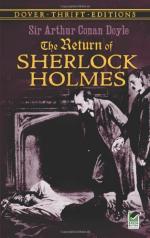When the youth had been dispatched with the note, Sherlock Holmes gave his instructions to the servants. If any visitor were to call asking for Mrs. Hilton Cubitt, no information should be given as to her condition, but he was to be shown at once into the drawing-room. He impressed these points upon them with the utmost earnestness. Finally he led the way into the drawing-room, with the remark that the business was now out of our hands, and that we must while away the time as best we might until we could see what was in store for us. The doctor had departed to his patients, and only the inspector and myself remained.
“I think that I can help you to pass an hour in an interesting and profitable manner,” said Holmes, drawing his chair up to the table, and spreading out in front of him the various papers upon which were recorded the antics of the dancing men. “As to you, friend Watson, I owe you every atonement for having allowed your natural curiosity to remain so long unsatisfied. To you, Inspector, the whole incident may appeal as a remarkable professional study. I must tell you, first of all, the interesting circumstances connected with the previous consultations which Mr. Hilton Cubitt has had with me in Baker Street.” He then shortly recapitulated the facts which have already been recorded. “I have here in front of me these singular productions, at which one might smile, had they not proved themselves to be the forerunners of so terrible a tragedy. I am fairly familiar with all forms of secret writings, and am myself the author of a trifling monograph upon the subject, in which I analyze one hundred and sixty separate ciphers, but I confess that this is entirely new to me. The object of those who invented the system has apparently been to conceal that these characters convey a message, and to give the idea that they are the mere random sketches of children.
“Having once recognized, however, that the symbols stood for letters, and having applied the rules which guide us in all forms of secret writings, the solution was easy enough. The first message submitted to me was so short that it was impossible for me to do more than to say, with some confidence, that the symbol XXX stood for E. As you are aware, E is the most common letter in the English alphabet, and it predominates to so marked an extent that even in a short sentence one would expect to find it most often. Out of fifteen symbols in the first message, four were the same, so it was reasonable to set this down as E. It is true that in some cases the figure was bearing a flag, and in some cases not, but it was probable, from the way in which the flags were distributed, that they were used to break the sentence up into words. I accepted this as a hypothesis, and noted that E was represented by XXX.




